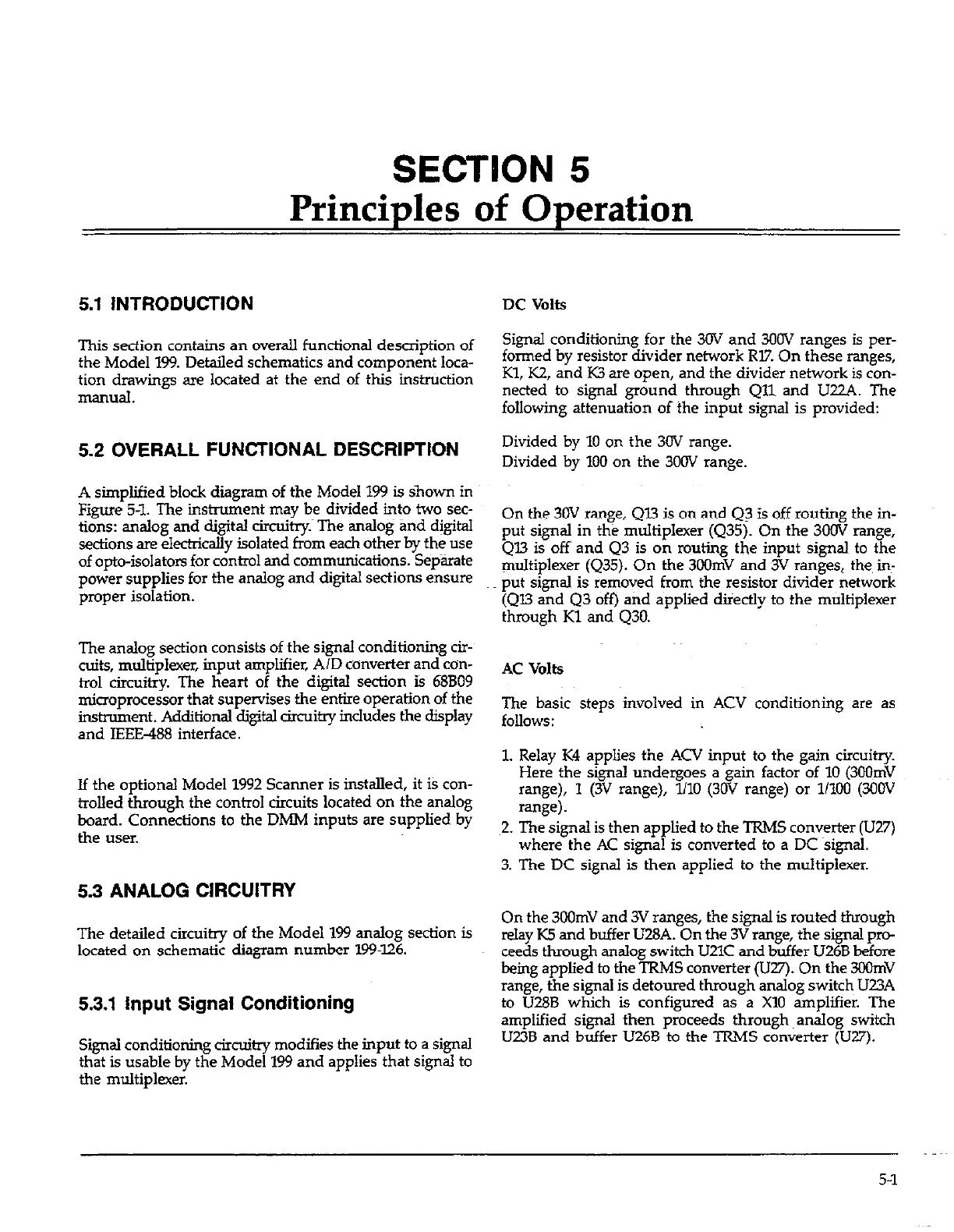SECTION 5
Principles of Operation
5.1 INTRODUCTION
This section contains an overall functional desaiption of
the Model 199. Detailed schematics and component loca-
tion drawings are located at the end of this instruction
manual.
5.2 OVERALL FUNCTIONAL DESCRIPTION
A simplified block diagram of the Model 199 is shown in
Figure 5-l. The instrument may be divided into two sec-
tions: analog and digital circuitry.~ The analog and d@tal
sections are electrically isolated from each other by the use
of opto-isolators for control and communications. Separate
power supplies for the analog and digital sections ensure
proper isolation.
The analog section consists of the signal conditioning cir-~
cuits, multiplexer, input amplifier, AID converter and con-
trol circuitry. The heart of the digital section is 68809
microprocessor that supervises the entire operation of the
instrument. Additional digital circuitry indudes the display
and IEEE-488 interface.
If the optional Model 1992 Scanner is installed, it is con-
trolled through the control circuits located on the analog
board. Connections to the DMM inputs are supplied by
the user.
5.3 ANALOG CIRCUITRY
The detailed circuitry of the Model 199 analog section is
located on schematic diagram number 199-126.
53.1 input Signal Conditioning
Signal conditioning circuitry modifies the input to a signal
that is usable by the Model 199 and applies that signal to
the multiplexer.
DC Volts
Signal conditioning for the 3OV and 300V ranges is per-
formed by resistor divider network R17. On these ranges,
Kl, K2, and K3 are open, and the divider network is con-
nected to signal ground through Qll and U22A. The
following attenuation of the input signal is provided:
Divided by 10 on the 30V range.
Divided by 100 on the 3COV range.
On the 3OV range, Ql3 is on and Q3 is off routing the in-
put signal in the multiplexer (Q35). On the 300V range,
Ql3 is off and Q3 is on routing the input signal to the
multiplexer (Q35). On the 3OOmV and 3V ranges, the in-
put signal is removed from the resistor divider network
(Ql3 and Q3 off) atid applied directly to the m&iplexer
through Kl and Q30.
AC Volts
The basic steps involved in ACV conditionixig are as
follows:
1. Relay K4 applies the ACV input to the gain circuitry.
Here the signal undergoes a gain factor of 10 (3OOmV
range), 1 (3V range), 1110 (30V range) or 11100 (300V
range).
J?I. The signal is then applied to the TRMS converter (U27)
where the AC signal is converted to a DC~signal.
3. The DC signal is then applied to the multiplexer.
On the 300mV and 3V ranges, the signal is routed through
relay KS and buffer U28A. On the 3V range, the signal pro-
ceeds through analog switch UZlC and buffer U26B before
being applied to the TRMS converter (U27). On the 3OOniV
range, the signal is detoured through analog switch~ U23A
to U28B which is configured as a X10 amplifier. The
amplified signal then proceeds through ~analog switch
U23B and buffer U26B to the TRMS converter (VU).
5-l

